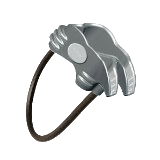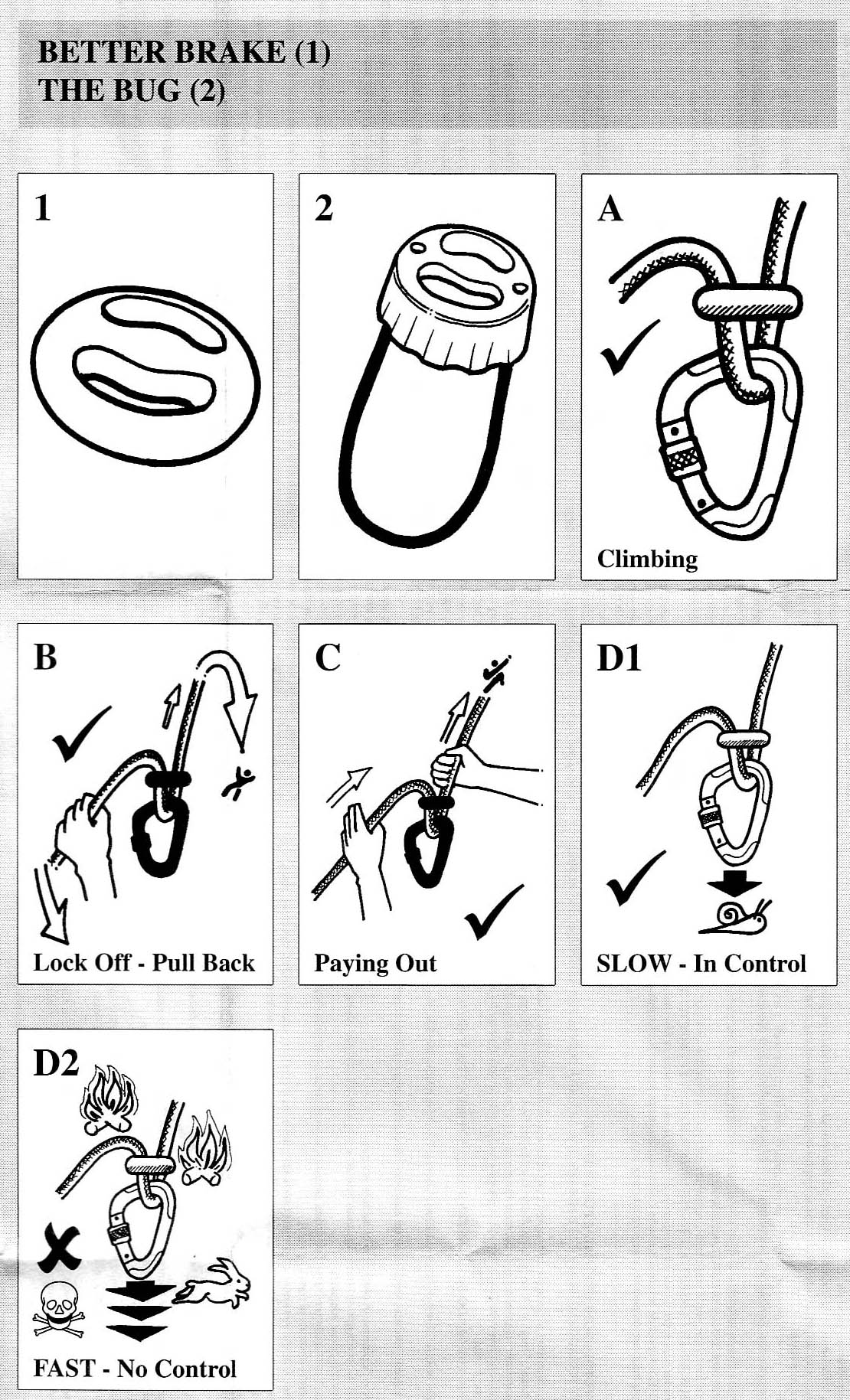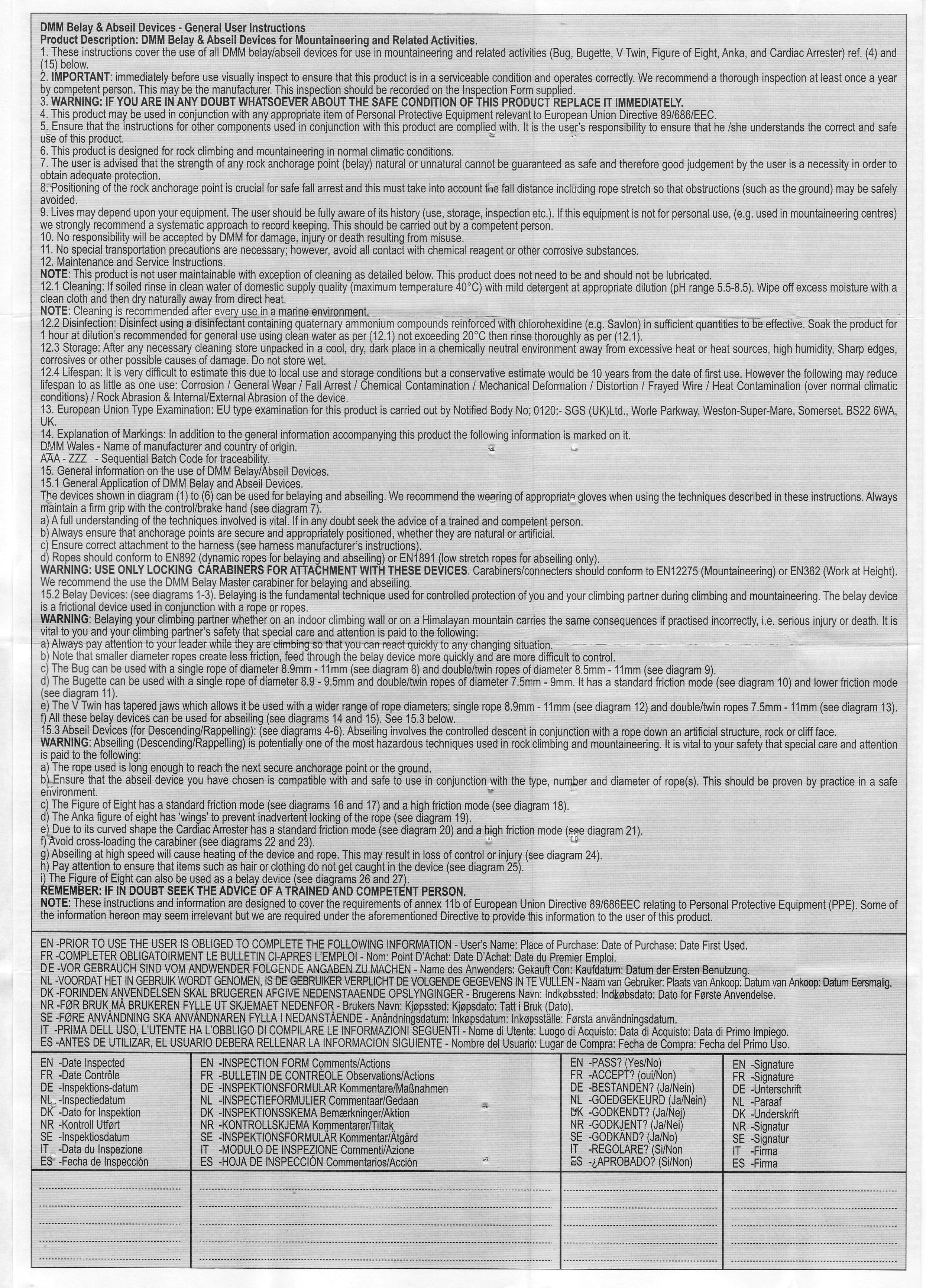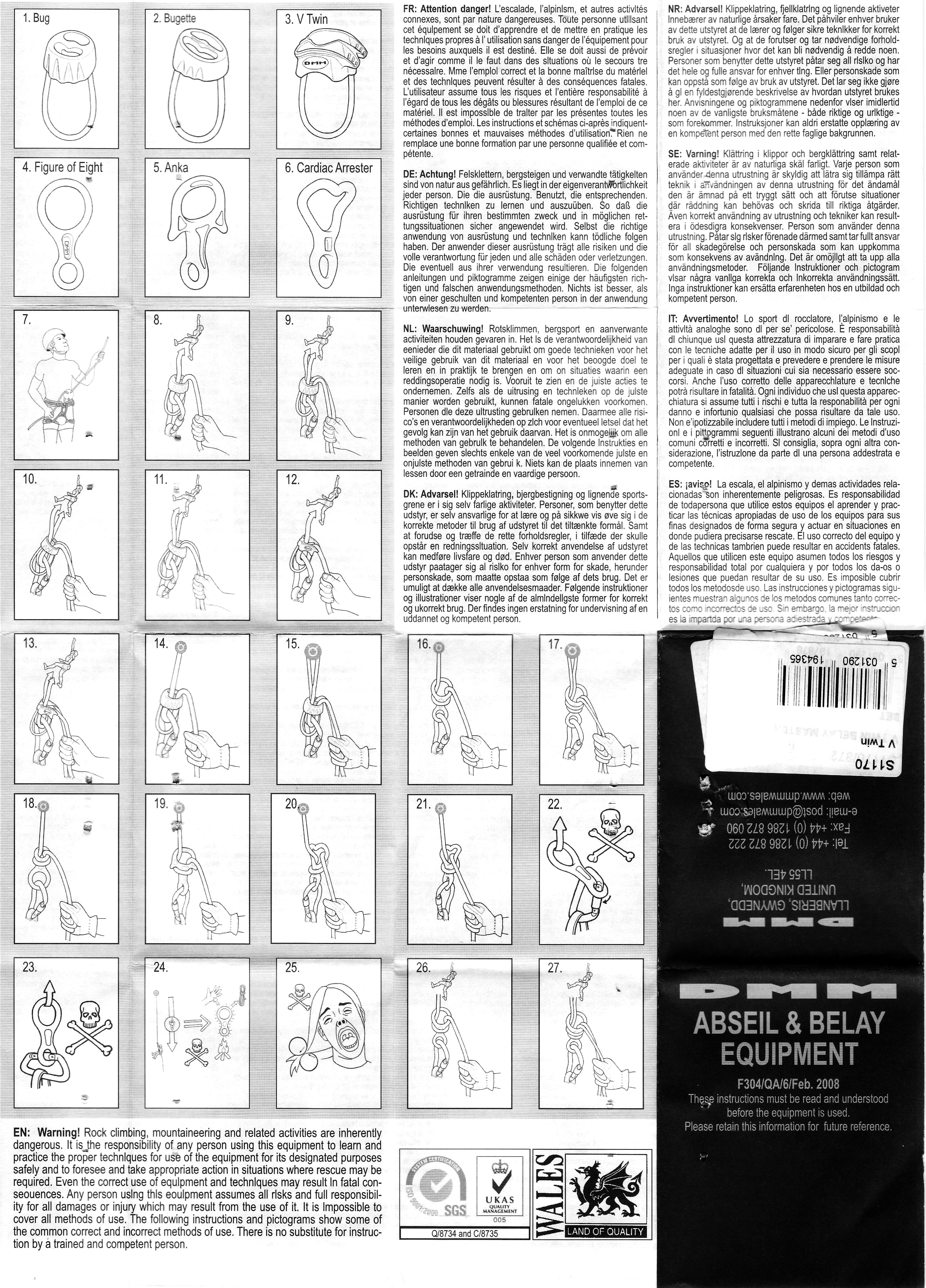Overview
 Several vendors showed a different V-Twin in their catalogs or advertisements; however, I have yet to find one with the alternate design. It never made it to production, but several prototypes were distributed for testing.
Several vendors showed a different V-Twin in their catalogs or advertisements; however, I have yet to find one with the alternate design. It never made it to production, but several prototypes were distributed for testing.
|
 |
If you can help me get one of the other versions, please email me. |
|
[ Top
| Bug, Version B
| Bug, Version C
| Bugette, Version A
| Bugette, Version B
| Mantis
| Pivot
| V-Twin, Version A
| V-Twin, Version B
| Return to Belay Tubes
]
Bug, Version A
(#687)
Technical Details
 I acquired my DMM Bug, Version A from Exkursion in 1995.
I acquired my DMM Bug, Version A from Exkursion in 1995.
The DMM Bug, Version A is forged from aluminum alloy and
then clear anodized. Mine is 52 mm. long, 56 mm. wide, 107 mm.
high, and weighs 71 g. The slots are 29 mm. long and 16 mm.
wide. The top of the Omega oval carabiner that I use for comparing
belay tubes sits 18 mm. below the ends of the slots. The
slots on the Bug have a distinct curve. The keeper is a thin (3 mm.),
flexible, plastic-covered cable.
One end of the bug is stamped with an insect logo, a rigging
icon, and "DMM WALES." The other end is stamped "AAD."
The DMM Bug is much like the other tube devices. The curved
slots do not appear to provide any particular advantage, but they
do make the bug wide than it is long. The thick walls are nice,
not only because they absorb heat but also because the unfinished
aluminum will wear quickly. The cable keeper is longer than the
keepers on other tubes, so it stays out of the way a bit better.
The keeper holes open at the top of the Bug, and the crimps holding
the keeper are visible through these holes.
[ Top
| Bug, Version A
| Bug, Version C
| Bugette, Version A
| Bugette, Version B
| Mantis
| Pivot
| V-Twin, Version A
| V-Twin, Version B
| Return to Belay Tubes
]
Bug, Version B
(#846)
Technical Details
 I acquired my DMM Bug, Version B from Northern Mountain
Supply in 2007.
I acquired my DMM Bug, Version B from Northern Mountain
Supply in 2007.
The DMM Bug, Version B is forged from aluminum alloy and
then hard anodized. Mine is 52 mm. long, 56 mm. wide,
100 mm. high, and weighs 82 g. The slots are 28 mm.
long and 15 mm. wide. The top of the Omega oval carabiner
that I use for comparing belay tubes sits 17 mm. below the
ends of the slots. The keeper is a moderately stiff, 4.4 mm.,
flexible, plastic-covered cable.
One end of the Bug is printed with "DMM," "WALES,"
"BUG," and a rigging icon. The other end is stamped
"EAE."
Version B is makes several changes. First, it is hard
anodized, so it should wear better. The keeper is thicker and
more rigid, which should help protect it better and make it last
longer. The keeper is now pinned in from the sides. The ribs on
the side are less prominent than on Version A.
[ Top
| Bug, Version A
| Bug, Version B
| Bugette, Version A
| Bugette, Version B
| Mantis
| Pivot
| V-Twin, Version A
| V-Twin, Version B
| Return to Belay Tubes
]
Bug, Version C
(#1787)
Technical Details
 I acquired my DMM Bug, Version C from Fell and Mountain in 2012.
I acquired my DMM Bug, Version C from Fell and Mountain in 2012.
Version C is a plain belay tube. It is forged from aluminum alloy and soft anodized. It has 2 slots and a plastic-covered cable keeper. The slots are 28 mm. long and 15 mm. wide. The top of the Omega oval carabiner that I use for comparing belay tubes sits 11 mm. below the ends of the slots. Version C is 56 mm. long, 52 mm. wide, 89 mm. high, and weighs 75 g.
One side is printed with "BUG," a dragon logo, and "MADE IN WALES." The other side is printed with a book-with-an-"i" icon, "121170486M," and a rigging diagram. The top is printed with "DMM."
Version C introduces a new exterior shape that reduces weight somewhat.
[ Top
| Bug, Version A
| Bug, Version B
| Bug, Version C
| Bugette, Version B
| Mantis
| Pivot
| V-Twin, Version A
| V-Twin, Version B
| Return to Belay Tubes
]
Bugette, Version A
(#792)
Technical Details
 I acquired my DMM Bugette from Shoreline Mountain Products
in 2004.
I acquired my DMM Bugette from Shoreline Mountain Products
in 2004.
The DMM Bugette is forged from aluminum alloy. Mine is 42 mm.
long, 41 mm. wide, 77 mm. high, and weighs 24 g.
The slots are 28 mm. long and 12 mm. wide. The top of
the Omega oval carabiner that I use for comparing belay tubes
sits 9 mm. below the ends of the slots. The Bugette has a
distinct wedge shape. The slots are D-shaped rather than oval.
The keeper is a moderately stiff plastic-covered wire.
The top of my Bugette is stamped "DMM."
The Bugette is a smaller tube belayer designed for use with 7.5 mm. to 9.5 mm. ropes. The D-shaped slots do not appear to provide
any particular advantage. The walls are thinner than on the bug,
so they heat and wear quickly. Note the wedge-shaped profile:
theoretically, this allows rigging the Bugette for greater or
lesser friction; however, I don't notice much difference between
the two options.
[ Top
| Bug, Version A
| Bug, Version B
| Bug, Version C
| Bugette, Version A
| Mantis
| Pivot
| V-Twin, Version A
| V-Twin, Version B
| Return to Belay Tubes
]
Bugette, Version B
(#1825)
Technical Details
 I acquired my DMM Bugette, Version B from GearX.com via Amazon.com in 2013.
I acquired my DMM Bugette, Version B from GearX.com via Amazon.com in 2013.
Version B is forged from aluminum alloy. Mine is 41 mm. long, 42 mm. wide, 76 mm. high, and weighs 27 g. The slots are 28 mm. long and 12 mm. wide. The top of the Omega oval carabiner that I use for comparing belay tubes sits 9 mm. below the ends of the slots. The Bugette has a
distinct wedge shape. The slots are D-shaped rather than oval.
The keeper is a moderately stiff plastic-covered wire.
I acquired my DMM Bugette from Shoreline Mountain Products
in 2004.
The top of my Bugette is stamped "DMM." The large end is printed with a rigging diagram.
The printed rigging diagram is the primary difference between Versions A and B.
[ Top
| Bug, Version A
| Bug, Version B
| Bug, Version C
| Bugette, Version A
| Bugette, Version B
| Pivot
| V-Twin, Version A
| V-Twin, Version B
| Return to Belay Tubes
]
Beetle
(#2794)
Technical Details
I acquired my DMM Beetle from CampSaver.com in 2020.
The DMM Beetle is a notched belay tube. It is forged from aluminum alloy and soft anodized. Mine is 54 mm. long, 41 mm. wide, 78 mm. high, and weighs 55 g. The slots are 33 mm. long and 14 mm. wide. The top of the Omega oval carabiner that I use for comparing belay tubes sits 21 mm. below the ends of the slots. The Beetle has two ribbed v-grooves ad a moderately stiff moderately stiff plastic-covered cable keeper.
One side is printed with a climber illustration, the DMM logo, "DMM," "BEETLE," and a hand-holding-a-rope illustration. The other side is printed with a hand-holding-a-rope illustration, "1Ø 8.5 - 11 mm," "∞½Ø 7.3-9.2 mm, the DMM logo, "DMM," "BEETLE," "200440735J," "B5", EN 15151-2," a book-with-an-"i" icon, and a limber illustration.
The Beetle is similar to the Mantis, described below, but with thicker walls. This adds 10 g. to the Beetle’s weight. This is not much in an absolute sense but 22% is significant. Like all small belay devices, it will get quite hot on long rappels, but heating should not be a problem for standard belaying.
[ Top
| Bug, Version A
| Bug, Version B
| Bug, Version C
| Bugette, Version A
| Bugette, Version B
| Pivot
| V-Twin, Version A
| V-Twin, Version B
| Return to Belay Tubes
]
Mantis
(#1885)
Technical Details
I acquired my DMM Mantis from Absolute Snow in 2016.
The DMM Mantis is a notched belay tube. It is forged from aluminum alloy and soft anodized. Mine is 53 mm. long, 38 mm. wide, 87 mm. high, and weighs 45 g. The slots are 34 mm. long and 14 mm. wide. The top of the Omega oval carabiner that I use for comparing belay tubes sits 15 mm. below the ends of the slots. The Mantis has two ribbed v-grooves ad a moderately stiff moderately stiff plastic-covered cable keeper.
One side is printed with the DMM logo, "DMM," "MANTIS," and a rigging illustration. The other side is printed with "1Ø 8.5-11 mm,"and "∞½Ø 7.3-9.2 mm," another rigging illustration, the DMM logo, "DMM," "MANTIS," "161403507E," "B6 EN 15151-2," and a book-with-an-"i" icon.
The Mantis is one of the lightest notched belay tubes, but it has thin walls with a large surface area. Like all small belay devices, it will get quite hot on long rappels, but heating should not be a problem for standard belaying.
[ Top
| Bug, Version A
| Bug, Version B
| Bug, Version C
| Bugette, Version A
| Bugette, Version B
| Mantis
| V-Twin, Version A
| V-Twin, Version B
| Return to Belay Tubes
]
Pivot
(#1870)
Technical Details
I acquired my DMM Pivot from Backcountry Gear in 2015.
The DMM Pivot is a notched belay tube. It is forged from aluminum alloy and soft anodized. Mine is 78 mm. long, 46 mm. wide, 71 mm. high, and weighs 72 g. The Pivot two slots with ribbed V-grooves at one end. The slots are 34 mm. long and 14 mm. wide. The top of the Omega oval carabiner that I use for comparing belay tubes sits 22 mm. below the ends of the slots. The Pivot has a hinged eye that pivots on a 5 mm. stainless steel pin. It has a moderately stiff cable keeper.
One side is printed with a DMM logo, "DMM," "PIVOT," and a rigging illustration for standard belaying. The other side is printed with "1Ø 8.7÷11 mm,"and "∞½Ø 7.3÷9.2 mm," a rigging illustration for guide mode belaying, "151411794A," "EPA141974958.4," "B6 EN 15151-2," and a book-with-an-"i" icon.
The pivoting eye gives the Pivot its name. It is used in guide-mode belaying. The illustrations suggest that it allows the pivot to rotate in the event of a fall, but of course, a fixed eye would rotate as well. The instructions warn, "The Pivot’s Guide Mode braking may be disabled if… one of the two seconds is hanging on his rope." This ambiguous statement does not inspire confidence, but I suppose their lawyer made them write it.
[ Top
| Bug, Version A
| Bug, Version B
| Bug, Version C
| Bugette, Version A
| Bugette, Version B
| Mantis
| Pivot
| V-Twin, Version B
| Return to Belay Tubes
]
V-Twin, Version A
(#888)
Technical Details
I acquired my DMM V-Twin, Version A from Backcountry Gear in 2008.
The DMM V-Twin is a notched belay tube. It is made from investment
cast stainless steel. Mine is 56 mm. long, 42 mm. wide,
100 mm. high, and weighs 89 g. The slots are 35 mm.
long and 16 mm. wide. The top of the Omega oval carabiner that
I use for comparing belay tubes sits 16 mm. below the ends
of the slots.
The V-Twin has two slots with ribbed V-grooves at one end.
It also has a moderately stiff, plastic-covered cable keeper.
One side of this V-Twin have plastic inserts marked with "DMM." This is a manufacturing defect. Close inspection shows glue traces, indicating that the insert fell off one side before it was delivered to me.
The V-Twin is and improved version of the ATC that
has V-slots that provide additional friction for belaying or rappelling.
Each side of each notch has three rounded ribs, giving the notches
"teeth" to grip the rope more effectively. These ribs
are vertical so they do NOT act to guide the rope deeper into
the slot as the teeth on the ATC-XP
do. The notches do not have the narrow angle found on the Trango Jaws and its equivalents,
so they do not create the same wedging action. For these reasons,
I find the V-Twin to be less effective. On the other hand, the
teeth on the V-Twin provide a larger bearing area for the rope,
which helps reduce localized heating.
The V-Twin is investment cast stainless steel which will make
it more durable than its aluminum competitors, but according to
DMM, the prime motivation was to reduce heating. Stainless steel
has a lower coefficient of friction against nylon rope than aluminum
does, especially if the rope is muddy. This means that the V-Twin
should not heat as rapidly, and testing indicates that this may
be true, but don't expect the V-Twin to remain cool after a long
or fast rappel.
The logo on the side appears to be a thick plastic sticker.
It does nothing, and may be removed. Some people tell me that
this is there to keep from burning your fingers - you can easily
guess my opinion about that. The V-Twin has a moderately stiff cable keeper that
is quite adequate . The V-Twin is rigged like the ATC,
with the V-slots on the brake hand end of the rope. Alternately,
the V-Twin may be reversed to disable the V-slots.
[ Top
| Bug, Version A
| Bug, Version B
| Bug, Version C
| Bugette, Version A
| Bugette, Version B
| Mantis
| Pivot
| V-Twin, Version A
| Return to Belay Tubes
]
V-Twin, Version B
(#1684, 1685)
Technical Details
I acquired two Version B DMM V-Twins in 2010, one from Mountain Gear and the other from Unique Outfitters.
These are identical to Version A except that both sides of Version B have plastic inserts marked with "DMM."
The logo does nothing, and may be removed. Version A shows that this may happen on its own.
[ Top
| Bug, Version A
| Bug, Version B
| Bug, Version C
| Bugette, Version A
| Bugette, Version B
| Mantis
| Pivot
| V-Twin, Version A
| V-Twin, Version B
]



 Several vendors showed a different V-Twin in their catalogs or advertisements; however, I have yet to find one with the alternate design. It never made it to production, but several prototypes were distributed for testing.
Several vendors showed a different V-Twin in their catalogs or advertisements; however, I have yet to find one with the alternate design. It never made it to production, but several prototypes were distributed for testing.

